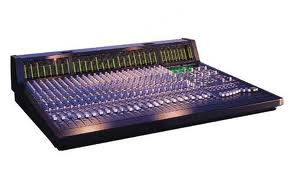General Menu In Audio Mixer
1. GAIN
Gain is found on the top of each channel mixing console. Its function is to determine how sensitive we want input received by the console. Is a mic signal or a signal line (keyboards, tape decks, etc). This button will be helpful to set the signal going into the console. When the signal is weak, it can be increased, if too strong can be reduced.
Then, input gain stage is the most important thing, because this is where all the sound quality starts. Therefore Try to keep each input remains clean and clear as possible. Because of noise and distortion caused in these points will continue to flow throughout the system and make all so disturbed. When was the input gain is very large or even too big sehigga net is also still too strong, so for that there are switches on the console PAD whose function is to reduce the gain of the input signal from -20 to -30 db.
2. EQ on channel
On every channel in the mixing console is always there Equalizer Section. Function, namely as a regulator of the incoming sound on that channel. Generally sound engineer to make changes sound through EQ seeks to change the sound of the instrument became the preferred sound frequency of the input and solve problems (feedback, hum, overtune, etc)
Very basic settings of the EQ is in the form of Low and Hi, later additions and deductions (boost / cut). Or there is also a more complex with a four lane with a full parametric functions. But no matter what type of EQ is contained in the console, because it remains the same goal to help find the best sound.

3. EQ fix
The definition above is the EQ fix does not hold the button to select the frequency that will gives a chance. Because frequency has been determined to be altered from the factory. EQ frequency division on the distribution of this species is similar to that found on the crossover, namely:
• Low, and Hi-2way in EQ
• Low, Mid and Hi-on 3way EQ
• Low, Low Mid, Hi Mid and Hi-on four-way EQ
Rotating the boost / cut will be in effect until 12 or 15 db depending on the mixing console of what you use. EQ Gain is the fix:
• Prices are relatively economical,
• pmilihanfrekuensi avoid mistakes that will gives a chance, a mistake like this can be caused by a sound engineer (sound stylist) who is less experienced.
• The last benefit is saving time in the pen-setting.
But there are also drawbacks as we can not choose a specific frequency that we want because all the frequencies have been determined from the manufacturer.
4. EQ Sweepable
Called Quasi Semi parametric or parametric (not full-parametric because no regulator bandwitch). In the full parametric EQ you can make settings for each parameter. Is that the parameters of frequency, bandwitch, or parameter level. This type of EQ has the ability to set-up is very flexible, and usually provides the control system of mid-range EQ with three or four lanes.
How it works:
1. Rotate button to select the frequency that the frequency will be regulated.
2. Turn the boost / cut for the addition or reduction in the frequency that we choose earlier. Let the other frequencies remain in the sound flat.
3. Turn the boost / cut it down to the left, or in a position approximately seven hours.
4. Turn the knob until the sound frequency that sounded boomy sound was missing.
5. After the frequency we are looking for has been met, do the settings again on the boost / cut. Because the cuts are too extreme on the low frequency sound can cause mid-sounding “empty”.
We can also make arrangements for vocals at a frequency of 3.5 kHz without affecting the overall frequency of other Mid Hi. Mixing console with a single mid settings can usually be bought with a more economical price, while other versions of mixing console is equipped with Low settings Mid and Hi Mid somewhat more expensive.








No trackbacks yet.